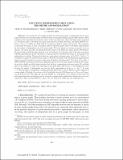| dc.contributor.author | Chandrasekaran, Venkat | |
| dc.contributor.author | Chertkov, Misha | |
| dc.contributor.author | Gamarnik, David | |
| dc.contributor.author | Shah, Devavrat | |
| dc.contributor.author | Shin, Jinwoo | |
| dc.date.accessioned | 2011-11-21T18:18:51Z | |
| dc.date.available | 2011-11-21T18:18:51Z | |
| dc.date.issued | 2010-07 | |
| dc.date.submitted | 2009-08 | |
| dc.identifier.issn | 0895-4801 | |
| dc.identifier.issn | 1095-7146 | |
| dc.identifier.uri | http://hdl.handle.net/1721.1/67258 | |
| dc.description.abstract | We consider the #P-complete problem of counting the number of independent sets in a given graph. Our interest is in understanding the effectiveness of the popular belief propagation (BP) heuristic. BP is a simple iterative algorithm that is known to have at least one fixed point, where each fixed point corresponds to a stationary point of the Bethe free energy (introduced by Yedidia, Freeman, and Weiss [IEEE Trans. Inform. Theory, 51 (2004), pp. 2282–2312] in recognition of Bethe’s earlier work in 1935). The evaluation of the Bethe free energy at such a stationary point (or BP fixed point) leads to the Bethe approximation for the number of independent sets of the given graph. BP is not known to converge in general, nor is an efficient, convergent procedure for finding stationary points of the Bethe free energy known. Furthermore, the effectiveness of the Bethe approximation is not well understood. As the first result of this paper we propose a BP-like algorithm that always converges to a stationary point of the Bethe free energy for any graph for the independent set problem. This procedure finds an ε-approximate stationary point in O(n2d42depsilon-4log3(nepsilon-1)) iterations for a graph of n nodes with max-degree d. We study the quality of the resulting Bethe approximation using the recently developed “loop series” framework of Chertkov and Chernyak [J. Stat. Mech. Theory Exp., 6 (2006), P06009]. As this characterization is applicable only for exact stationary points of the Bethe free energy, we provide a slightly modified characterization that holds for ε-approximate stationary points. We establish that for any graph on n nodes with max-degree d and girth larger than 8d log2 n, the multiplicative error between the number of independent sets and the Bethe approximation decays as 1+O(n-γ) for some γ>0. This provides a deterministic counting algorithm that leads to strictly different results compared to a recent result of Weitz [in Proceedings of the Thirty-Eighth Annual ACM Symposium on Theory of Computing, ACM Press, New York, 2006, pp. 140–149]. Finally, as a consequence of our analysis we prove that the Bethe approximation is exceedingly good for a random 3-regular graph conditioned on the shortest cycle cover conjecture of Alon and Tarsi [SIAM J. Algebr. Discrete Methods, 6 (1985), pp. 345–350] being true. | en_US |
| dc.description.sponsorship | National Science Foundation (U.S.) (NSF EMT/MISC collaborative project 0829893) | en_US |
| dc.language.iso | en_US | |
| dc.publisher | Society for Industrial and Applied Mathematics | en_US |
| dc.relation.isversionof | http://dx.doi.org/10.1137/090767145 | en_US |
| dc.rights | Article is made available in accordance with the publisher's policy and may be subject to US copyright law. Please refer to the publisher's site for terms of use. | en_US |
| dc.source | SIAM | en_US |
| dc.title | Counting Independent Sets Using the Bethe Approximation | en_US |
| dc.type | Article | en_US |
| dc.identifier.citation | Chandrasekaran, Venkat et al. “Counting Independent Sets Using the Bethe Approximation.” SIAM Journal on Discrete Mathematics 25 (2011): 1012. © 2011 Society for Industrial and Applied Mathematics. | en_US |
| dc.contributor.department | Massachusetts Institute of Technology. Department of Electrical Engineering and Computer Science | en_US |
| dc.contributor.department | Massachusetts Institute of Technology. Laboratory for Information and Decision Systems | en_US |
| dc.contributor.department | Massachusetts Institute of Technology. Operations Research Center | en_US |
| dc.contributor.department | Sloan School of Management | en_US |
| dc.contributor.approver | Gamarnik, David | |
| dc.contributor.mitauthor | Gamarnik, David | |
| dc.contributor.mitauthor | Chandrasekaran, Venkat | |
| dc.contributor.mitauthor | Shah, Devavrat | |
| dc.relation.journal | SIAM Journal on Discrete Mathematics | en_US |
| dc.eprint.version | Final published version | en_US |
| dc.type.uri | http://purl.org/eprint/type/JournalArticle | en_US |
| eprint.status | http://purl.org/eprint/status/PeerReviewed | en_US |
| dspace.orderedauthors | Chandrasekaran, Venkat; Chertkov, Misha; Gamarnik, David; Shah, Devavrat; Shin, Jinwoo | en |
| dc.identifier.orcid | https://orcid.org/0000-0001-8898-8778 | |
| dc.identifier.orcid | https://orcid.org/0000-0003-0737-3259 | |
| mit.license | PUBLISHER_POLICY | en_US |
| mit.metadata.status | Complete | |
